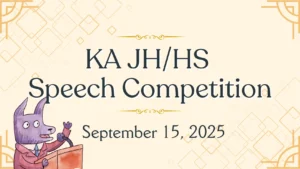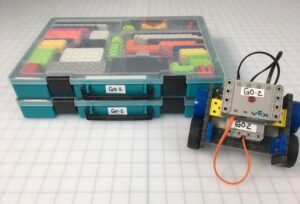The title of this article, inspired by the iconic character Yoda, illustrates an interesting point. His grammar is almost always off, yet we all understand him perfectly and often imitate his style when we want to sound wise or share something simple and profound. But what if Yoda truly spoke an alien language no one could understand? Of course, we wouldn’t get it. Then it wouldn’t be a grammar versus pronunciation issue—it would just be indecipherable.
Almost the same thing happens when someone can’t pronounce words they actually know. Like with any foreign language, saying “muya na mey es yo da” instead of “My name is Yoda” leaves listeners lost. Our international school students face this daily—mispronunciation can make even simple words sound alien and alienate them from their classmates.
That’s why clear pronunciation outweighs grammar. Grammar, while useful, is often overemphasized at the expense of speech clarity.
Pronunciation: The Force of Clear Communication
Pronunciation grabs your listener’s attention first; it’s the gateway to being understood. It’s like the opening credits of a movie. If it’s blurry or jumbled, you’ll lose the audience before the story even begins.
Imagine you’re watching a movie with such poor audio quality that the dialogue is incomprehensible. You see characters moving their mouths, but if you can’t understand the words, the plot is lost. That’s what poor pronunciation feels like to your listeners.
Grammar can sometimes become a crutch that overshadows clear speech. Although it can help the story flow better, listeners will struggle to appreciate well-structured sentences if the words aren’t clearly understood.
For example:
- If a student says, “I go store now,” it’s grammatically incorrect, but the meaning is clear.
- But if a student says, “I am going to the store now” with slurred or wrong sounds, it’s hard to understand, even though the grammar is perfect.
In my experience observing teachers during professional development sessions, I noticed a common problem: some teachers would hammer on a student’s grammar mistakes while completely missing opportunities to correct mispronunciations of the most basic vowel sounds. The “teachable moment” for pronunciation was often overlooked, as if grammar were the only thing worth fixing.
Small pronunciation mistakes can turn simple words into something unrecognizable — and confuse listeners. This is especially true for tricky English sounds like:
- The “th” sound in this is very hard for many learners.
- The difference between /r/ and /l/ sounds is what many Japanese learners struggle with.
- Vowel sounds that change meaning, like in ship vs sheep.
I’ve heard it so often that no single moment stands out. When a student uses perfect grammar but poor pronunciation, I catch it right away and work it into the lesson naturally. It’s such a common occurrence in my classes that individual instances blur together into one continuous process of small adjustments.
Mastering these sounds creates a positive feedback loop. Being understood builds the confidence to speak more, and speaking more is how real learning happens.
Speaking of mispronunciations, I once had an online lesson where I was teaching the “magic e” rule—the silent “e” that changes the vowel sound in words like “cake” and “take”. When the student tried one of the examples, it unexpectedly came out sounding like a completely different, and rather awkward, word. I quickly corrected the pronunciation and moved on, but it remained with me as a reminder of how one small vowel can completely change the meaning of a word; sometimes in surprising ways.
Grammar: Forgiving, It Is
In my experience teaching mostly Japanese children, I’ve found that listeners often “fill in the blanks” for grammar mistakes without much trouble. Even when students forget small but important bits—like using “a”, “an”, or “the” before nouns, or leaving off the -s for plurals—the meaning is usually clear. These are some of the most common grammar slips, and they tend to fade over time with plenty of repetition and practice.
Another tricky area is the -ed ending of past-tense verbs. This isn’t just a grammar problem—it’s also a pronunciation challenge, because -ed can sound like t, d, or ed, depending on the word. So, pronunciation and grammar intertwine here in interesting ways.
Grammar mistakes definitely matter less in casual spoken English compared to formal writing. After all, most people don’t see the errors when people speak, unlike in written text, where mistakes jump off the page. Writers sometimes try to capture natural speech with poor grammar in novels, but it reads very differently on paper than it sounds aloud. Classic American literature often demonstrates this focus on pronunciation through written dialect. John Steinbeck’s Of Mice and Men provides a clear example when Lennie dreams of their future farm, exclaiming they will “live off the fatta the lan’.” Steinbeck writes it this way not because the grammar is wrong, but to capture the sound of Lennie’s uneducated, regional speech. Similarly, Harper Lee in To Kill a Mockingbird uses dialect to show social context, as when Calpurnia code-switches at her church, saying, “They’s my comp’ny.” The altered pronunciation and grammar signal a deliberate shift in how she speaks to be understood and accepted within her community. In both cases, the authors emphasize that how words are spoken is essential to conveying character and meaning, often more so than perfect grammatical structure.
I’ve had students pause mid-sentence, hesitating as they try to remember the correct particle or article – “a”, “an”, or “the”. This kind of hyper-focus on grammar slows them down and affects their confidence.
I do work on correcting grammar as much as pronunciation, because both are important. But in my teaching style, I always emphasize the importance of pronunciation—it’s the key to being understood and feeling confident to speak.
Balancing grammar and pronunciation is about knowing when to correct gently and when to encourage. I want my students to keep talking, even if the grammar isn’t perfect yet, because that’s how they really learn.
Why Pronunciation Outweighs Grammar: A Clear Voice, You Must Have
As Lado (1957, p. 2) pointed out in Linguistics Across Cultures, “a teacher who has made a comparison of the foreign and native language of the students will be better equipped to deal with their anticipated problems and consequently provide better teaching for them.” This is especially true when it comes to pronunciation.
One of the biggest reasons students struggle to focus on pronunciation over grammar comes down to the sounds their native language has—or doesn’t have. Take Japanese, for example. Unlike English, which contains thousands of possible syllable combinations, Japanese uses a syllabary system with a much smaller set—roughly 100–110 core syllables, plus a few variations (Vance, 2008, p. 45). English’s vast syllable inventory comes from its complex phonology, including multiple consonant clusters and vowel sounds. According to the Carnegie Mellon University Pronouncing Dictionary, English has over 10,000 unique syllables when considering all sound and stress pattern combinations (CMUdict, 2024). This limited range in Japanese means many English sounds simply don’t exist in their native tongue, making pronunciation a significant challenge from the start.
When students improve their pronunciation, I’ve definitely noticed a boost in their confidence. It’s almost like a dopamine reward system kicks in—when they hear a teacher smile and say “Good job!” it motivates them to keep trying and improving. It’s basically a Jedi mind trick: praise triggers that feel-good chemical dopamine in the brain, making learning feel rewarding and encouraging students to push themselves more. Of course, mixing in some strong but fair correction keeps them on the right path without crushing their spirit. (For the science buffs out there, see Henderikx et al., 2020 and Nakata, 2006 for studies on praise, motivation, and learning.)
While listeners can often mentally correct minor grammatical slips (like a missing ‘s’ or ‘the’), it’s much harder to decipher poorly pronounced words. When a student’s pronunciation is unclear, the burden shifts entirely to the listener, who must act as a detective, piecing together sounds and context clues. This extra effort can cause the conversation to stall and lead to frustration, proving that clear pronunciation is the foundation on which a listener can even begin to appreciate the grammar.
Rather than spending a lot of time explaining why pronunciation matters, I find it more effective to teach it correctly from the beginning. Especially with young Japanese students, their learning curve can feel slow at first, but like a sponge, they suddenly have bursts of understanding, then it tapers off until the next breakthrough happens. It’s better to build a solid foundation early, so those breakthroughs come more easily and faster.
Teaching Pronunciation to Young Learners: Phonics and the Jedi Way
When it comes to teaching young learners pronunciation, starting with the basics is key. The vowels are the foundation—without them, words simply can’t be pronounced properly. After vowels, I focus on consonants. Using guides like the most common 100 words is a handy reference once students grasp simple CVC (consonant-vowel-consonant) words. I’ve used Jolly Phonics before, though I’m a bit skeptical about their choices for the order of vowels and syllables. And while much of my training leans on Common Core principles, I’m not exactly a fan—my style tends to veer off that beaten path.
Making pronunciation practice fun and engaging? Pictures work wonders—especially animal personification. Puppets can be great too, although I haven’t used them much myself. Honestly, the thing that works best for me is just having natural conversations with the kids. I chat with them like normal people, and when they say something funny or clever, I make a point to praise them. That humor and encouragement make the whole learning process a lot less scary.
I do sprinkle in some Star Wars references sometimes; though many of my students are pretty young, and Star Wars might be a bit old school for them. I always ask what they’re watching on YouTube or TV these days, and they’re happy to share. My “unorthodox” approach is to blend lesson plans into natural conversations as much as possible. I think part of why I teach this way goes back to when I was about 12. Moving to a mostly Hispanic neighborhood in the U.S., I had to quickly learn to communicate with kids who barely spoke English. It was sink or swim, and that experience shaped how I see language learning—not just memorizing rules, but talking and listening naturally.
Young learners face a different challenge than adults when it comes to pronunciation. Their learning curve is kind of logarithmic—at first, slow and steady, then suddenly, boom!—big jumps in understanding, followed by plateaus. Adults, however, often struggle more. Their brains and ears are wired differently, thanks to muscle memory. For example, a Japanese adult visiting New York might hear the city’s noise as just noise—but if someone shouts “Konnichiwa,” their ears perk up instantly at that familiar sound. They’re used to the rhythm and tone of their native language, making it harder to adapt to new sounds.
To involve parents and schools in supporting pronunciation, I like to use apps like SeeSaw to share short videos of students’ progress. It gives parents a peek into what their kids are learning and keeps everyone connected. Of course, I’m just a small fish in a big education pond, and my way of teaching doesn’t always line up with Common Core or other systems. But that’s exactly why I’m writing down these thoughts: to share my unorthodox approach and hopefully help others see the value in pronunciation.
Practical Tips for Students and Schools: A Jedi’s Guide to Mastery
When it comes to improving pronunciation, there’s no magic wand—just consistent, daily effort. My top three tips for students are simple but effective:
- Immerse yourself in English media. Watch TV shows, movies, and cartoons in English. Animated shows work especially well because they tend to exaggerate pronunciation in a way that’s easy to mimic.
- Designate English-only days. Pick a couple of days each week where you only speak English, no matter what. It forces your brain to think in English instead of constantly translating from your native language.
- Use English in daily life. Whether you’re talking to a classmate, a teacher, or even the cat—try it in English. The more you use it, the more natural it feels. (And hey, cats don’t judge your accent.)
For schools, supporting pronunciation can’t just be an afterthought tacked onto grammar lessons. Grammar and pronunciation need to work together. That means building in activities like speaking drills, quick-fire Q&A sessions, and role-plays. Give students repeated opportunities to use the sounds they’re learning, instead of leaving it all to chance.
In the classroom, I like to keep activities fun and low-pressure. Show and tell in English works well—students bring something in and talk about it. Kids’ songs in English are another winner; music helps lock pronunciation patterns into memory. And then there’s my favorite: just asking students what they’re thinking about. If they answer in Japanese, I gently push them to say it in English. I even know a teacher who pretends to sneeze whenever someone speaks Japanese in class, claiming she’s “allergic to Japanese.” It’s silly, but it works—the kids start self-correcting before she even gets the fake sneeze out.
Technology can help, too. I teach Scratch programming, which, believe it or not, sneaks in a lot of English speaking and listening. Apps like Kids A-Z are also fantastic for structured reading and pronunciation practice. There are tons of tools out there—the trick is finding the ones that fit your students’ age, skill level, and interests.
Finally, don’t underestimate the power of peer practice. Practicing pronunciation with classmates builds not just skill but confidence. Without that social element, students may lose the courage to speak up at all, which is far more damaging than any grammar mistake.
Conclusion: Clear, Your Speech Must Be
If you take away only one thing from all this, it’s this: Grammar is great, but without clear pronunciation, communication breaks down faster than a house of cards in a breeze. For young learners, especially, pronunciation is the foundation that makes all the other skills—reading, writing, listening—click in real conversations.
Mistakes? Oh, I love mistakes. Formula 409 failed 408 times before they got it right. That’s not failure, that’s data collection. In language learning, every wrong turn is just a signpost pointing you toward the right way. You can’t fix what you never try. So, trip over the words. Laugh at yourself. And keep going.
Some students get so nervous they almost sink into their chairs to avoid being seen. For them, I bring it back to rapport. I’ll switch to an easier question, make a quick joke, and praise even a short answer. And when it’s time to try again, I use my “assumptive close” trick: ask the question and look away, giving them space to respond without feeling like they’re under a spotlight. It’s amazing how much more they’ll say when you take the pressure off.
As for my own motivation? I’m stubborn, a bit of a dinosaur, and probably not reading every new education theory paper out there. But I teach from real experience, and nothing keeps me going like seeing that “lightbulb moment” in a student’s eyes. That’s better than any award, and it’s the reason I keep showing up.
So I’ll leave you with a slightly mangled, but very true Yoda-ism:
“The greatest teacher, failure is. But quit, you must not.”
References
- Carnegie Mellon University. (2024). Carnegie Mellon University pronouncing dictionary (CMUdict). Retrieved from http://www.speech.cs.cmu.edu/cgi-bin/cmudict
- Henderikx, M., Kreijns, K., & Kalz, M. (2020). The impact of praise on student engagement and learning outcomes. Journal of Educational Psychology, 112(3), 523–534. https://doi.org/10.1037/edu0000393
- Lado, R. (1957). Linguistics across cultures: Applied linguistics for language teachers. University of Michigan Press.
- Lee, H. (1960). To kill a mockingbird. J.B. Lippincott & Co.
- Nakata, Y. (2006). English pronunciation teaching in Japan: Current practices and challenges. Journal of Language Teaching and Research, 7(2), 225–232.
- Steinbeck, J. (1937). Of mice and men. Covici, Friede.
- Vance, T. J. (2008). The phonology of Japanese. Oxford University Press.






